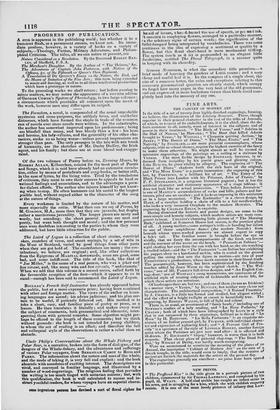FINE ARTS.
THE CABINET OF MODERN ART
Is the title of a set of twenty-four highly-finished engravings, forming, we believe, the illustrations of the Literary Souvenir. These, though superior in their general character to the rest of the tribe of Annuals, of which, in respect of its embellishments, it is the chief, share the de- fects common to all, namely, want of interest in the subjects and of power in their treatment. " The Birth of Venus," and " Sabrina in the Hall of Nereus," by Howartn ; " The Boar that killed Adonis brought to Venus," by WESTALL ; " Cleopatra quitting Actium," by JONES ; " The Bower of Diana," " The Muse Erato," and " The Nativity," by STOTHARD, —are mere pictorial commonplaces, whose subjects, trite as school. themes, require the highest exercise of the fancy to make them otherwise. We might almost as well be treated to miniature engravings of the paintings on a ceiling or a staircase by VERRIO. The most feeble design by STOTHARD, however, is re- deemed from insipidity by his poetic grace and glowing colour. Like RUBENS, he gives vitality to allegory. The engraving of" The Bower of Diana" shadows forth the rich hues of the original, and "The Muse Erato" is a poetic incarnation : the engraving of this last, by PORTBURY, is a brilliant bit of art. " The Entry of the Black Prince into London with his Prisoner, John of France," by F. P. STEPHANO1F, is a gorgeous historical pageant ; but it has the artificial character and stationary appearance of a stage tableau : it does not look like an actual procession. " Titus before Jerusalem"- is one of MARTIN'S accumulations of rocks and hills, palaces and for- tresses, piled one on another; and it looks as imposing in this miniature as in a large mezzotint. " The Embroider" is a clever design, by HART, of a cavalier holding a skein of silk to a fair needleworker, who looks a very innocent Omphale to the modern Hercules. The engraving, by CHARLES ROLLS, is exquisite.
Having dismissed the historic and poetic designs, we come to the more simple and homely subjects, Which modern artists are more corn- petent to treat. COLLINS'S charming little picture of "The Morning Bath," exhibited at Somerset House last season, is the prettiest plate of ell. A young mother—some cottager's wife—is banding her infant to one of those amphibious dames (the modern Nereids) from beneath whose wave-washed garments we almost expect to espy
a fish's tail. The familiar scene is brought before the eye so vividly, that we fancy the accompaniments of the fresh sea-breeze and the murmur of the waves on the beach. "Peasants at Subiaco "- a girl shading her eyes from the sun with her hand, as she sits watching a cradled infant—and the " The Fantoccini "—an Italian boy exhibiting his puppet-show to a barefooted urchin, who is seated on the ground pulling the string that sets the figure in motion—are two of poor EDMONSTONE'S productions, whose merit consists in their literal truth. The peasantsgirl, however, has been sophisticated by the finishing touches added by JOHN WOOD to the original sketch. "The Wel- come," one of Mr. PARRIS'S full-dress designs, and "An English Cot- tage-door," one of WESTALL'S smug mannerisms, are specimens of the artificial style of treating subjects of fashionable and rustic life, for which these artists are notorious.
Of landscapes there are but two ; and one of them (to use an Irishism)
is a marine view, " Venice," by BENTLEY, but neither very clever nor characteristic. The architectural composition, "A Ruined Fountain," by J. CHALON, is a little too formal and studied, but elegant withal ; and the effect of a bright twilight at sunset is beautifully true. The engraving, by ROBERT Waws, is full of light and colour.
There is, as usual, an assortment of "fancy heads ;" including one of
NEWTON'S studies of a lady reading, and "La Rosa Parlante," by CitaLoN; both of which have been lithographed by LANE in a style that is not surpassed by these engravings, brilliant as is this of La Rosa" by H. ROBINSON. "La Bella Fortunate" is an exquisite mi- niature of an Italian peasant girl, by FF.CENER, with individual charac- ter and expression of a pleasing kind ; and " A Peasant Girl of Pro- eida " is a specimen of the style of LEOPOLD ROBERT, another foreign artist whom the Parisians are just now mad after : it is affected and ill-drawn. F. ROCHARD'S " Gipsy," however, is worse than it in both respects. That clever piece of pictorial clap-trap, "The Dead Sol- dier," by WRIGHT of Derby, was hardly worth reengraving. Were we accustomed to scrutinize the meaning of the plates of an Annual, the inscription "Cabinet of Modern Art" on the ruin of a Greek temple, in the title, would seem to imply, that the remains of ancient art furnish the materials for the artists of the present day.
The engravings generally are excellent : no pains have been spared in this particular.


























 Previous page
Previous page